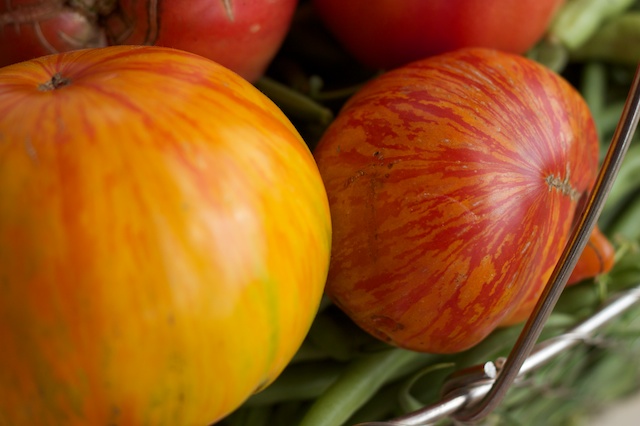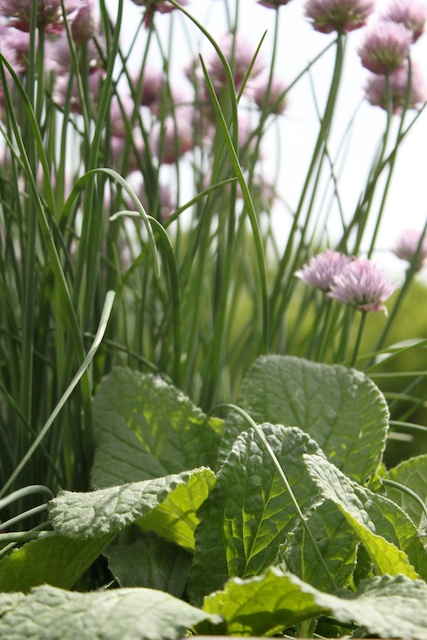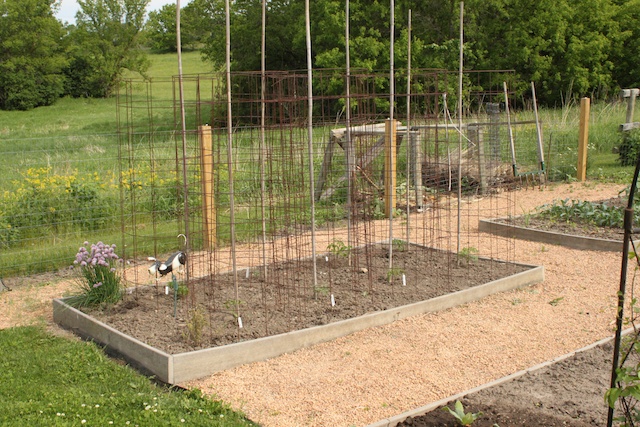With the Help of Heavy-Duty Concrete Reinforcing Wire.
I finally bought my tomato and pepper plants. I should really buy them sooner. Actually, I should start them from seed in March. Better yet, I should save my seed from the previous year, thereby keeping only the best…
You see? You see the black hole of my thoughts?
How can I ever be happy and satisfied when I am constantly being shoulded-upon?
Back to the tomatoes.
They are itty-bitty little things, but that’s OK, they’ll catch up. I have learned over the years, that even when I buy a large tomato and plant it with itty bitty tomato plants, the small ones tend to catch up. The big ones might even have tomatoes on them and yet they only produce red tomatoes maybe a week sooner. In fact, I think transplanting the larger tomatoes stresses them and sets them back. Otherwise it just doesn’t make sense.
I even bought a large 2′ tomato plant this year to test it and really watch it so I could do a controlled experiment and chronicle it here. An Early Girl hybrid, since all the rest of my plants were to be heirlooms.
Well, forget about that plan. Because I forgot about that plant. Forgot to water it. And now it’s dead. Too bad I forgot to take a picture, because once I got over being mad, it was pretty funny.
Aside from doing nothing and letting the vines sprawl on the ground, there are two main ways to grow tomatoes. Staking and caging. There are pros and cons to each.
Pros of Staking: If driven deep into the ground, staked plants won’t blow over like caged plants can. Many say staked plants produce larger fruit because plant energy is concentrated on the tomatoes and not on excess foliage . There is less disease due to more air circulation (though that didn’t seem to help me all that much). Staked plants take up less room.
Cons of Staking: Staked plants have less foliage which can reduce the sweetness of the tomato and can promote sun-scald in high heat/sun areas. Pruning takes commitment. (Basically, what that means is, if you plan to go out of town for more than a day or two, forget it. You will come home to chaos. In your frantic effort to get the plants back to one stem, you will need to “pinch off” a 1″ diameter sucker. You will inadvertently pinch off the central leader and doom your tomato plant to a stunted existence. And your hands will always smell like tomato plants.)
I used to always stake, because that’s how my mom did it. Simple as that.
I even tried the staking method that has you wind the stems around strings run vertically. It was an interesting season. It ended in disaster when the whole rig came crashing down from the top. I suppose that’s another downside of staking. IF something happens to the main stem, it’s a goner.
I was never good at staking.
Now I cage.
But caging hasn’t been without its own set of problems. Aside from strong winds that have blown my cages over, I’ve been through many iterations of the cage. The ones you buy at the store are, what? Two or three feet high? Even in Minnesota with a short growing season, most plants grow to twice that size. Honestly, there ought to be a law against 3′ tomato cages… In order to find a cage that was actually tall enough to support the plants, I was forced to make my own, which then made staking seem like a better idea again…
But no, I persevered. I bought wire and made the cages. I only forgot one small detail: you have to be able to get your hand through the wire to pick the tomatoes.
Not to worry. I used wire cutters and cut larger holes here and there. The bummer was, the holes never seemed to be in the right place, and when I stuck my hand through, I inevitably cut my hand on the sharp wire.
They were the worst tomato cages ever! [Maybe even as bad as the ones the stores sell.]
Tomato cage adaptation number three was the one I had been trying to avoid: concrete reinforcing wire. You buy it in rolls that weigh about 200 pounds. I’m not kidding. It wasn’t something I could do by myself. Since I am not a team player, and I don’t like to ask for help, I had avoided it for several years. But it was clear: if I didn’t want to stake my plants, and if I didn’t want to be making tomato cages every damn year, then I was going to have to ask Dave for help gettin’ me a load of concrete reinforcing wire home from Home Depot. [Why doesn’t someone go into business selling these?]
It was a big job, and since doing it more than 6 years ago, I’ve never had to make another tomato cage again. They really are worth the effort. They are heavy, don’t blow over and have nice, large holes for your hands. They patina (rust) as they age and fit right in aesthetically… I’ve even grown pole beans and other climbing things on them. They are the best tomato cages ever! But caging also has its pros and cons.
Pros of Caging: Easy; not much maintenance. Supports the plants. Bushier growth and more greens-to-red ratio promotes sweeter tomatoes, or so they say.
Cons of Caging: Sometimes a weaker plant doesn’t grow bushy enough to truly be supported by the cage. Smaller fruits. Cages takes up more room per plant. Plants are more prone to disease if growth is dense and shady
Still, I’m a cager. This year, though, I’m trying something new: I’m planting the tomato at the base of a stake inside the cage so that should the plant need additional support, there will be something there to tie it to.
Genius, I know.
I also usually prune the early suckers (growth at occurs at the “v” between the stem and lateral branch) until they get away from me.
Back to the act of planting of my tomatoes.
FIRST, I had to decide where to put the tomato plants: inside the garden proper or outside it, where they were last year when I moved them out by the squash and pumpkins because I had had two bad tomato years in a row with early blight.
What’s early blight?
Early blight is some lame generic term for: your-tomatoes-are-dying-from-the-ground-up-earlier-than-they-should-be-and-who-knows-why.
You know, the leaves turn spotty yellow then spotty brownish black. Then the stem falls off. Then the spotties hop from one branch to the next until all you have is a vertical plant with about 5 leaves at the very top and 10 tomatoes on it. The fruits will still ripen, but they don’t taste as good because it’s the healthy greens that give the tomato its sweetness. I hate early blight. It’s like having a glaring failure for all the world to see when they walk through your garden…
So I moved them out by the squash and melons hoping to get away from what I figured was contaminated dirt inside my garden. The blight was less pronounced out there. Maybe that’s because they were watered exclusively with a soaker hose. (Tomatoes don’t like to be watered from the top. Tell that to the Creator who deemed otherwise). It was a hard decision and one that I had given a lot of thought to. I was still on the fence until I went out there with the plants and compared the current state of my planting site choices:
Hmmm. Tough choice. Let’s see. I can spend the next 4 hours weeding the patch outside the garden…. Or I can spend 5 minutes weeding the box inside the garden. Hmmmmm.
So the tomatoes are inside the garden this year. We’ll see how it goes.
And just so you know. I actually pulled out some borage seedling volunteers that were all around the chives. I didn’t move them to another spot (I was short on time). I didn’t leave them there to enjoy. I ruthlessly pulled them out.
And I still feel bad out it.
So this is how it looks all finished:
and a little closer:
…and should you ever require nice unobtrusive stakes for you pepper plants (because mine always break in a storm), consider another concrete reinforcing product: rods!
I think they look almost arty.







Sylvana says
I was considering buying those really big tomato cages that came out in the last few years, But at $10 each, I think your cages would be far better. Right now I use those foldable garden fences with the fluer de lis decoration. They work very well, but aren’t tall enough and the tomatoes flop over the top.
admin says
You should post a picture of your folding fences. I think I know what you mean, but can’t imagine that they can hold up to a huge plant. Do you prune to a few stems and tie them? I should note that on a good growing year (read: no early blight!) the tomatoes grow over the tops of these cages, too. I’m trying to get better about pruning the growing tips to stop new growth at that stage, but it’s hard. I always want them to grow as HIGH AS THEY CAN!
Dave says
I have the same problem with early blight. I spokenwith a local tomato grower who suggested checking the pH of the soil since tomatoes prefer acidic soil. Haven’t had a chance to try that idea out yet.
admin says
That make a lot of sense Dave. I think I remember reading that somewhere a long time ago too. And I know that I do have slightly alkaline soil, so it would fit. I’m just– and if you read much here you will know– an unreliably lazy gardener. If its something I have to do two or three times a year I’m sunk. Maybe a jug of muriatic acid would do the trick?? Heh heh